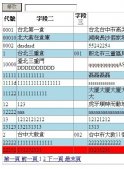.net实体类与json相互转换时,注意要点:
1.jsonhelp编写时候添加的引用。System.Runtime.Serialization.Json;
2.实体类需声明为public
jsonhelp代码:
|
1
2
3
4
5
6
7
8
9
10
11
12
13
14
15
16
17
18
19
20
21
22
23
24
25
26
27
28
29
30
31
32
33
34
35
36
37
38
39
40
41
42
43
44
45
46
47
48
49
50
51
52
53
54
55
56
57
58
59
60
61
62
63
64
|
using System;using System.Collections.Generic;using System.Linq;using System.Text;using System.Threading.Tasks;using System.Runtime.Serialization.Json;using System.IO;namespace JsonTest{ class JsonHelp { public JsonHelp() { // // TODO: Add constructor logic here // } /// <summary> /// 把对象序列化 JSON 字符串 /// </summary> /// <typeparam name="T">对象类型</typeparam> /// <param name="obj">对象实体</param> /// <returns>JSON字符串</returns> public static string GetJson<T>(T obj) { //记住 添加引用 System.ServiceModel.Web /** * 如果不添加上面的引用,System.Runtime.Serialization.Json; Json是出不来的哦 * */ DataContractJsonSerializer json = new DataContractJsonSerializer(typeof(T)); using (MemoryStream ms = new MemoryStream()) { json.WriteObject(ms, obj); string szJson = Encoding.UTF8.GetString(ms.ToArray()); return szJson; } } /// <summary> /// 把JSON字符串还原为对象 /// </summary> /// <typeparam name="T">对象类型</typeparam> /// <param name="szJson">JSON字符串</param> /// <returns>对象实体</returns> public static T ParseFormJson<T>(string szJson) { T obj = Activator.CreateInstance<T>(); using (MemoryStream ms = new MemoryStream (Encoding.UTF8.GetBytes(szJson))) { DataContractJsonSerializer dcj = new DataContractJsonSerializer(typeof(T)); return (T)dcj.ReadObject(ms); } } }} |
实体类代码:
|
1
2
3
4
5
6
7
8
9
10
11
12
13
14
15
16
17
18
19
|
using System;using System.Collections.Generic;using System.Linq;using System.Text;using System.Threading.Tasks;namespace JsonTest{ public class testData { public testData() { } public int Id { get; set; } public string Name { get; set; } public string Sex { get; set; } }} |
控制台应用程序测试代码:
|
1
2
3
4
5
6
7
8
9
10
11
12
13
14
15
16
17
18
19
20
21
22
23
24
25
26
27
28
29
30
31
32
33
34
35
36
37
38
39
40
41
42
43
44
|
using System;using System.Collections.Generic;using System.Linq;using System.Text;using System.Threading.Tasks;namespace JsonTest{ class Program { static void Main(string[] args) { //实体类转json testData t1 = new testData(); t1.Id = 1; t1.Name = "001姓名"; t1.Sex = "男"; testData t2 = new testData(); t2.Id = 2; t2.Name = "002姓名"; t2.Sex = "男"; testData t3 = new testData(); t3.Id = 3; t3.Name = "003姓名"; t3.Sex = "男"; List<testData> tlist = new List<testData>(); tlist.Add(t1); tlist.Add(t2); tlist.Add(t3); Console.WriteLine(JsonHelp.GetJson<List<testData>>(tlist)); // Console.ReadKey(); //json转实体类 List<testData> tl = JsonHelp.ParseFormJson <List<testData>>(JsonHelp.GetJson<List<testData>>(tlist)); Console.WriteLine(tl.Count); Console.WriteLine(tl[0].Name); Console.ReadKey(); } }} |
以上就是本文的全部内容,希望对大家的学习有所帮助,也希望大家多多支持服务器之家。














